Camber,
Caster & Toe
The
three major alignment parameters are toe, camber, and caster. Most
enthusiasts have a good understanding of what these settings are and what
they involve, but many may not know WHY a particular setting is called
for, or HOW it affects performance. Here are the basic aspects of steering
tuning.
TOE
When
a pair of wheels is set so that their leading edges are pointed slightly
towards each other, the wheel pair is said to have toe-in. If the leading
edges point away from each other, the pair is said to have toe-out. The
amount of toe can be expressed in degrees as the angle to which the wheels
are out of 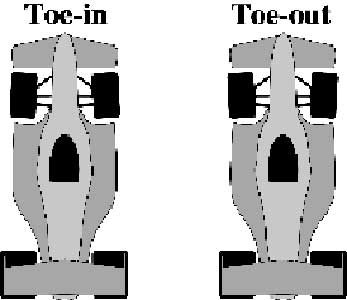 parallel,
or more commonly, as the difference between the track widths as measured
at the leading and trailing edges of the tyres or wheels. Toe settings
affect three major areas of performance: tyre wear, straight-line stability
and corner entry handling characteristics.
parallel,
or more commonly, as the difference between the track widths as measured
at the leading and trailing edges of the tyres or wheels. Toe settings
affect three major areas of performance: tyre wear, straight-line stability
and corner entry handling characteristics.
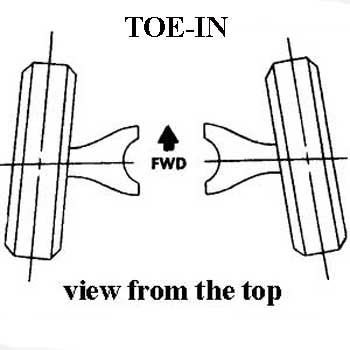 For
minimum tyre wear and power loss, the wheels on a given axle of a car should
point directly ahead when the car is running in a straight line. Excessive
toe-in or toe-out causes the tyres to scrub, since they are always turned
relative to the direction of travel. Too much toe-in causes accelerated
wear at the outboard edges of the tyres, while too much toe-out causes
wear at the inboard edges.
For
minimum tyre wear and power loss, the wheels on a given axle of a car should
point directly ahead when the car is running in a straight line. Excessive
toe-in or toe-out causes the tyres to scrub, since they are always turned
relative to the direction of travel. Too much toe-in causes accelerated
wear at the outboard edges of the tyres, while too much toe-out causes
wear at the inboard edges.
So
if minimum tyre wear and power loss are achieved with zero toe, why have
any toe angles at all? The answer is that toe settings have a major impact
on directional stability. The illustrations at right show the mechanisms
involved. With the steering wheel centered, toe-in causes the wheels to
tend to roll along paths that intersect each other. Under this condition,
the wheels are at odds with each other, and no turn results.
When
the wheel on one side of the car encounters a disturbance, that wheel is
pulled rearward about its steering axis. This action also pulls the other
wheel in the same steering direction. If it's a minor disturbance, the
disturbed wheel will steer only a small amount, perhaps so that it's rolling
straight ahead instead of toed-in slightly. But note that with this slight
steering input, the rolling paths of the wheels still don't describe a
turn. The wheels have absorbed the irregularity without significantly changing
the direction of the vehicle. In this way, toe-in enhances straight-line
stability.
If
the car is set up with toe-out, however, the front wheels are aligned so
that slight disturbances cause the wheel pair to assume rolling directions
that do describe a turn. Any minute steering angle beyond the perfectly
centered position will cause the inner wheel to steer in a tighter turn
radius than the outer wheel. Thus, the car will always be trying to enter
a turn, rather than maintaining a straight line of travel. So toe-out
encourages the initiation of a turn, while toe-in discourages it.
The
toe setting on a particular car becomes a tradeoff between the straight-line
stability afforded by toe-in and the quick steering response promoted by
toe-out. Nobody wants their street car to constantly wander over tar strips-the
never-ending steering corrections required would drive anyone batty. But
racers are willing to sacrifice a bit of stability on the straight-away
for a sharper turn-in to the corners. So street cars are generally set
up with toe-in, while race cars are often set up with toe-out.
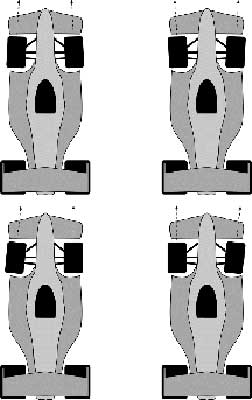
With
toe-in (left) a deflection of the
suspension
does not cause the
wheels
to initiate a turn as with
toe-out
(right).
The
amount of toe-in or toe-out dialed into a given car is dependent on the
compliance of the suspension and the desired handling characteristics.
To improve ride quality, street cars are equipped with relatively soft
rubber bushings at their suspension links, and thus the links move a fair
amount when they are loaded. Race cars, in contrast, are fitted with steel
spherical bearings or very hard urethane, metal or plastic bushings to
provide optimum rigidity and control of suspension links. Thus, a street
car requires a greater static toe-in than does a race car, so as to avoid
the condition wherein bushing compliance allows the wheels to assume a
toe-out condition. Trad Morgans have a single bush at each links No change
is necessary for racers..
BTW,
designers have been using bushing compliance to advantage. To maximize
transient response, it is desirable to use a little toe-in at the rear
to hasten the generation of slip angles and thus cornering forces in the
rear tyres. By allowing a bit of compliance in the front lateral links
of an A-arm type suspension, the rear axle will toe-in when the car enters
a hard corner; on a straight-away where no cornering loads are present,
the bushings remain undistorted and allow the toe to be set to an angle
that enhances tyre wear and stability characteristics.
CASTOR
Caster
is the angle to which the steering pivot axis is tilted forward or rearward
from vertical, as viewed from the side. If the pivot axis is tilted backward
(that is, the top pivot is positioned farther rearward than the bottom
pivot), then the caster is positive; if it's tilted forward, then the caster
is negative.
Positive
caster tends to straighten the wheel when the vehicle is traveling forward,
and thus is used to enhance straight-line stability. The mechanism that
causes this tendency is clearly illustrated by the castoring front wheels
of a shopping cart (above). The steering axis of a shopping cart wheel
is set forward of where the wheel contacts the ground. As the cart is pushed
forward, the steering axis pulls the wheel along, and since the wheel drags
along the ground, it falls directly in line behind the steering axis. The
force that causes the wheel to follow the steering axis is proportional
to the distance between the steering axis and the wheel-to-ground contact
patch-the greater the distance, the greater the force. This distance is
referred to as "trail."
Due
to many design considerations, it is desirable to have the steering axis
of a car's wheel right at the wheel hub. If the steering axis were to be
set vertical with this layout, the axis would be coincident with the tyre
contact patch. The trail would be zero, and no castoring would be generated.
The wheel would be essentially free to spin about the patch (actually,
the tyre itself generates a bit of a castoring effect due to a phenomenon
known as "pneumatic trail," but this effect is much smaller than that created
by mechanical castoring, so we'll ignore it here). Fortunately, it is possible
to create castoring by tilting the steering axis in the positive direction.
With such an arrangement, the steering axis intersects the ground at a
point in front of the tyre contact patch, and thus the same effect as seen
in the shopping cart casters is achieved.
The
tilted steering axis has another important effect on suspension geometry.
Since the wheel rotates about a tilted axis, the wheel gains camber as
it is turned. This effect is best visualized by imagining the unrealistically
extreme case where the steering axis would be horizontal as the steering
wheel is turned, the road wheel would simply change camber rather than
direction. This effect causes the outside wheel in a turn to gain negative
camber, while the inside wheel gains positive camber. These camber changes
are generally favorable for cornering, although it is possible to overdo
it.
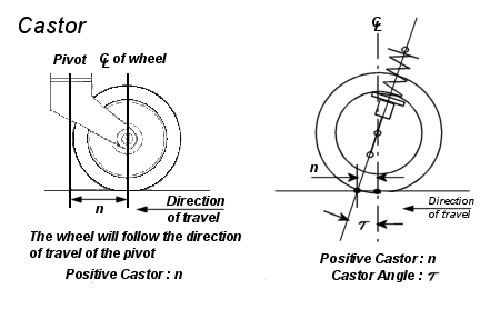
Like
a shopping cart wheel (left) the trail
created
by the castoring of the steering
axis
pulls the wheels in line.
Most
cars are not particularly sensitive to caster settings and they cannot
be changed on trad Morgans without the use of muscle as there is no adjustment
feature built in. Nevertheless, it is important to ensure that the caster
is the same on both sides of the car to avoid the tendency to pull to one
side. While greater caster angles serve to improve straight-line stability,
they also cause an increase in steering effort. Three to five degrees of
positive caster is the typical range of settings.
CAMBER?
Camber
is the angle of the wheel relative to vertical, as viewed from the front
or the rear of the car. If the wheel leans in towards the chassis, it has
negative camber; if it leans away from the car, it has positive camber
(see next page). The cornering force that a tyre can develop is highly
dependent on its angle relative to the road surface, and so wheel camber
has a major effect on the road holding of a car. It's interesting to note
that a tyre develops its maximum cornering force at a small negative camber
angle, typically around neg. 1/2 degree. This fact is due to the contribution
of camber thrust, which is an additional lateral force generated by elastic
deformation as the tread rubber pulls through the tyre/road interface (the
contact patch).
To
optimize a tyre's performance in a corner, it's the job of the suspension
designer to assume that the tyre is always operating at a slightly negative
camber angle. This can be a very difficult task, since, as the chassis
rolls in a corner, the suspension must deflect vertically some distance.
Since the wheel is connected to the chassis by several links which must
rotate to allow for the wheel deflection, the wheel can be subject to large
camber changes as the suspension moves up and down. For this reason, the
more the wheel must deflect from its static position, the more difficult
it is to maintain an ideal camber angle. Thus, the relatively large wheel
travel and soft roll stiffness needed to provide a smooth ride in passenger
cars presents a difficult design challenge, while the small wheel travel
and high roll stiffness inherent in racing cars reduces the engineer's
headaches.
It's
important to draw the distinction between camber relative to the road,
and camber relative to the chassis. To maintain the ideal camber relative
to the road, the suspension must be designed so that wheel camber relative
to the chassis becomes increasingly negative as the suspension deflects
upward. The illustration on the bottom of page 46 shows why this is so.
If the suspension were designed so as to maintain no camber change relative
to the chassis, then body roll would induce positive camber of the wheel
relative to the road. Thus, to negate the effect of body roll, the suspension
must be designed so that it pulls in the top of the wheel (i.e., gains
negative camber) as it is deflected upwards.
While
maintaining the ideal camber angle throughout the suspension travel assures
that the tyre is operating at peak efficiency, designers often configure
the front suspensions of passenger cars so that the wheels gain positive
camber as they are deflected upward. The purpose of such a design is to
reduce the cornering power of the front end relative to the rear end, so
that the car will understeer in steadily greater amounts up to the limit
of adhesion. Understeer is inherently a much safer and more stable condition
than oversteer, and thus is preferable for cars intended for the public.
Since
most independent suspensions are designed so that the camber varies as
the wheel moves up and down relative to the chassis, the camber angle that
we set when we align the car is not typically what is seen when the car
is in a corner. Nevertheless, it's really the only reference we have to
make camber adjustments. For competition, it's necessary to set the camber
under the static condition, test the car, then alter the static setting
in the direction that is indicated by the test results.
The
best way to determine the proper camber for competition is to measure the
temperature profile across the tyre tread immediately after completing
some hot laps. In general, it's desirable to have the inboard edge of the
tyre slightly hotter than the outboard edge. However, it's far more important
to ensure that the tyre is up to its proper operating temperature than
it is to have an "ideal" temperature profile. Thus, it may be advantageous
to run extra negative camber to work the tyres up to temperature.

(TOP
RIGHT) Positive camber: The bottoms of the wheels are closer together than
the tops. (LEFT) Negative camber: The tops of the wheels are closer together
than the bottoms. (CENTER) When a suspension does not gain camber during
deflection, this causes a severe positive camber condition when the car
leans during cornering. This can cause funky handling. (RIGHT Fight the
funk: A suspension that gains camber during deflection will compensate
for body roll. Tuning dynamic camber angles is one of the black arts of
suspension tuning.
KINGPIN INCLINATION
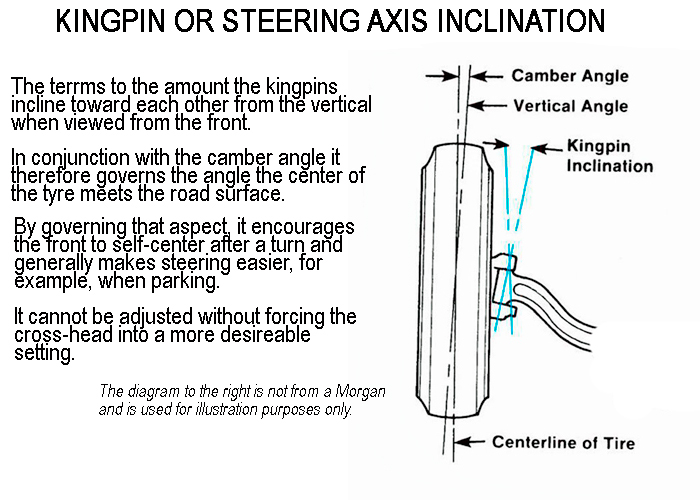
Kingpin Inclination or Steering Axis Inclination is
the angle between kingpin axis from
the perpendicular when viewed from the front of the car. One
calculates the angle of the kingpin from top to bootom and determines
its inclination away fro the perpenticular.
This angle was originally called
kingpin inclination for all cars, but not all cars use kingpins any
more. Morgans trads still do.
Effectively, it is the degree of the alignment of the tops of the kingpins tipped inward or outward in relation to each other. This normally places the center line of the Steering axis
nearer the center line of the tire-road contact area. Thus, in
conjunction with the camber, when the vehicle comes out of a turn,
the steering wheel returns to the straight-ahead position.
An alignment adjustment of this factor is not possible without force.
See CAMBER (above) as well.
Front suspension specifications
If
you take your car to an alignment shop, be sure to tell them you want
to know the Camber angle, Castor angle and the kingpin inclination.
I suggest you do not tell them what the values are supposed to be at first. Let them tell you!
|
PLUS 8s and ROADSTERs 1982-2006 |
PRE-1970 4/4s & PLUS 4s |
| TOE IN |
0 to 1/8" (3.2mm) |
1/8-3/16" (3.2 to 4.8mm) |
| CAMBER ANGLE |
1 degree negative + or - 0.5 degree. |
2 degrees positive camber (top of the tires slant outward
like this "\ /") |
| CASTOR ANGLE |
4 degrees |
4 degrees for all 4/4 Series II through Vs and +4s with the TR engines |
| KINGPIN INCLINATION |
2 degrees |
2 degrees for all 4/4 Series II through Vs and +4s with the TR engines |
These
last 3 items are fixed by the design and assembly of the front
suspension. While it is conceivable that they can be adjusted it is done
with brute force. So stop and think about it before changing any of
these settings unless the car has just been in an accident. (I would be
remiss if I did not point out at this time that there is a "modification
to the front suspension call a "negative camber" mod. This will change
the tire stance from " \ /" to "/ \" ). However, this modification will
take a little work and there is some discussion as to its applicability
for street use. Fred Sisson as a fine write up about it in his book and Gerry Wilburn comments below.
Tuning Up Front (EARLY
CARS THAT HAVE SWITCHED TO RADIAL TYRES ONLY)
by Gerry Willburn
DECAMBERING A MORGAN (for
a 0 camber): I will not attempt to go into the pros and cons of decambering
your Morgan.
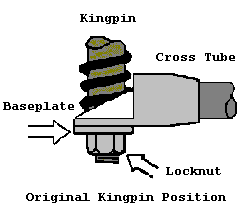 To
decamber your Morgan, you must move the bottom of the kingpin outboard
with respect to the top. This can be accomplished in several ways. On the
Le Mans cars, Chris Lawrence had longer bottom tubes made for the cross-axle.
The local slalom crowd has been using "Decamber Plates". This is a replacement
base plate with the hole for the kingpin moved 3/4" outboard. This is a
very simple modification to make and the only drawback seems to be that
a greater strain is put on the two mounting bolts for the base plate (because
of the greater offset). Grade 5 or better bolts should be used here and
torque them to 20 lbs. feet.
To
decamber your Morgan, you must move the bottom of the kingpin outboard
with respect to the top. This can be accomplished in several ways. On the
Le Mans cars, Chris Lawrence had longer bottom tubes made for the cross-axle.
The local slalom crowd has been using "Decamber Plates". This is a replacement
base plate with the hole for the kingpin moved 3/4" outboard. This is a
very simple modification to make and the only drawback seems to be that
a greater strain is put on the two mounting bolts for the base plate (because
of the greater offset). Grade 5 or better bolts should be used here and
torque them to 20 lbs. feet.
| Webmaster Note: I would suggest that you manufacture
the new base plate (see drawing) before starting the following procedure. |
| Webmaster Update: (July 2012) Considering the
LATEST.
one can now purchase adjustable camber plates at from the MMC. |
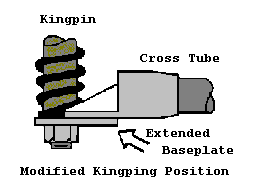
THE PROCEDURE
-
Disassemble the front suspension
-
The end of the cross-axle will have to be modified for the
larger offset. If it has not cracked already over the years, cut away the
outer edge of the flange on the cross-axle as shown.
-
Mount the new base plate to the kingpin and reassemble the
suspension. Be sure to use 5/16" grade 5 or better bolts to hold the base
plate to the cross-axle, and to torque them to 20 foot lbs.
-
The last step is to adjust the toe-in. As you have effectively
increased the distance between the two front wheels, toe in will be excessive
unless the track rod is also lengthened.
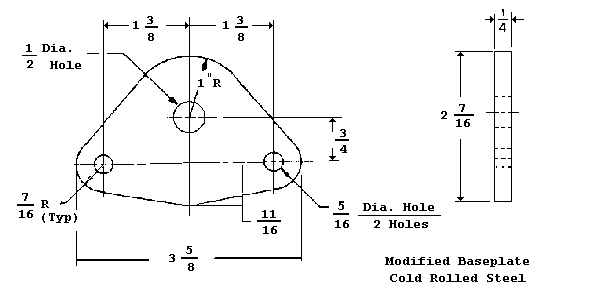
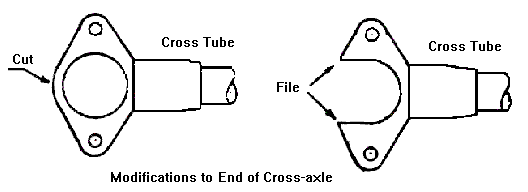
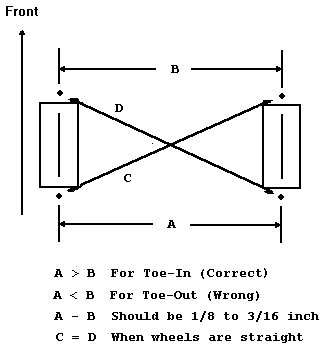 Toe-In Measurement
Toe-In Measurement
The easiest method that I have found (aside from taking
the car to your friendly local alignment shop) for adjusting toe-in is
to use a plumb-bob. Any weight, like a nut on the end of a string, will
do.
1. First, jack up
the front of the car, spin the front wheels, and mark the approximate
centerline of the tread with a piece of chalk.
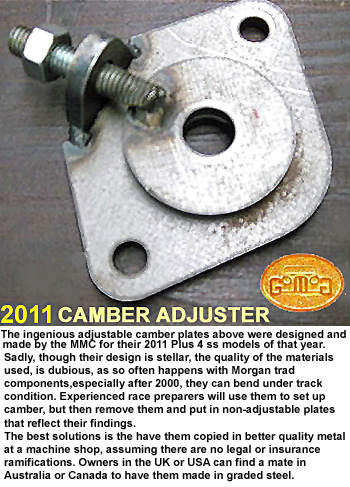 2. Now lower the
car to the floor With the wheels pointed straight ahead and then drop the
plumb-bob from both the front and rear centerline of each front wheel.
Mark the position of the garage floor with a piece of chalk.
2. Now lower the
car to the floor With the wheels pointed straight ahead and then drop the
plumb-bob from both the front and rear centerline of each front wheel.
Mark the position of the garage floor with a piece of chalk.
3. Now, measure the
distance rear to rear, front to front, and the diagonals. As in the sketch.
4. The toe-in is
the difference between the front and rear measurements. If the rear distance
is greater you have toe-in. If the front measurement
is larger, you have toe-out you should have is 1/8 to 3/16 inch of toe-in. ie. shorter in
the front.
Toe-in Adjustment
Note: If you forgot to mark the position of the clamp
or if you just wanted to check the centering of the steering, do it now
before you tighten the clamp on the tie rod.
SPECIAL
NOTE: CAMBER ON WIDEBODIES (+8s from 1998 on and all cars from 2004) July
2012
There
are "rumors" that the crossheads made for the widebody (used on some
Plus
8s from 1998 and later on classic models from 2004) are imprecise,
resulting
in non-matching and/or non-ideal camber set-ups for the cars affected.
A tyre shop or mechanic who is fully equipped with a precision steering
alignment device can quickly confirm whether your Morgan is afflicted.
The cure will require a Morgan knowledgeable machinist to remachine the
camber as required. However, though there is no news that the crosshead
has been remachined as yet, the Morgan Motor Company started using
adjustable
camber plates on the 2011 Plus 4 Super Sports and reported in the
MorganWire at that time) . These are now being fit to the wider
Roadster
3.7. The factory is now using them to adjust out the errant camber
before
delivery. Owners who confirm the issue on their cars can then inquire
whether
it can cure the problem. We suggest you have the camber checked before
approaching your Morgan dealer and expert (bring the written results to
them). Car manufacturers will always have recommended toe and caster
settings. They are supposed to arrive at these numbers through exhaustive
testing and experience. The only owners who need normally change
the
stock camber are racers.
 parallel,
or more commonly, as the difference between the track widths as measured
at the leading and trailing edges of the tyres or wheels. Toe settings
affect three major areas of performance: tyre wear, straight-line stability
and corner entry handling characteristics.
parallel,
or more commonly, as the difference between the track widths as measured
at the leading and trailing edges of the tyres or wheels. Toe settings
affect three major areas of performance: tyre wear, straight-line stability
and corner entry handling characteristics.
 For
minimum tyre wear and power loss, the wheels on a given axle of a car should
point directly ahead when the car is running in a straight line. Excessive
toe-in or toe-out causes the tyres to scrub, since they are always turned
relative to the direction of travel. Too much toe-in causes accelerated
wear at the outboard edges of the tyres, while too much toe-out causes
wear at the inboard edges.
For
minimum tyre wear and power loss, the wheels on a given axle of a car should
point directly ahead when the car is running in a straight line. Excessive
toe-in or toe-out causes the tyres to scrub, since they are always turned
relative to the direction of travel. Too much toe-in causes accelerated
wear at the outboard edges of the tyres, while too much toe-out causes
wear at the inboard edges.




 To
decamber your Morgan, you must move the bottom of the kingpin outboard
with respect to the top. This can be accomplished in several ways. On the
Le Mans cars, Chris Lawrence had longer bottom tubes made for the cross-axle.
The local slalom crowd has been using "Decamber Plates". This is a replacement
base plate with the hole for the kingpin moved 3/4" outboard. This is a
very simple modification to make and the only drawback seems to be that
a greater strain is put on the two mounting bolts for the base plate (because
of the greater offset). Grade 5 or better bolts should be used here and
torque them to 20 lbs. feet.
To
decamber your Morgan, you must move the bottom of the kingpin outboard
with respect to the top. This can be accomplished in several ways. On the
Le Mans cars, Chris Lawrence had longer bottom tubes made for the cross-axle.
The local slalom crowd has been using "Decamber Plates". This is a replacement
base plate with the hole for the kingpin moved 3/4" outboard. This is a
very simple modification to make and the only drawback seems to be that
a greater strain is put on the two mounting bolts for the base plate (because
of the greater offset). Grade 5 or better bolts should be used here and
torque them to 20 lbs. feet.



 Toe-In Measurement
Toe-In Measurement
 2. Now lower the
car to the floor With the wheels pointed straight ahead and then drop the
plumb-bob from both the front and rear centerline of each front wheel.
Mark the position of the garage floor with a piece of chalk.
2. Now lower the
car to the floor With the wheels pointed straight ahead and then drop the
plumb-bob from both the front and rear centerline of each front wheel.
Mark the position of the garage floor with a piece of chalk.